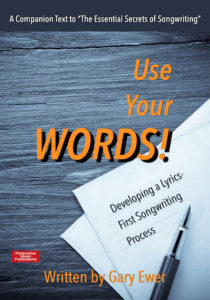There is research out there that tells us that people like listening to sad music. It doesn’t necessarily bring them down, and in fact can have an opposite, buoyant effect. That’s because as listeners, we want to feel something, and as long as whatever the sad song is about isn’t describing our own state of affairs too poignantly, we’re actually fine with sad music. This article from “Psychology Today” from 2015 goes into more detail.
 Trying to get a handle on writing song lyrics? Discover the benefits of making a lyrics-first method your new go-to process with”Use Your Words! Developing a Lyrics-First Songwriting Process. It’s FREE right now when you purchase the 10-eBook Bundle.
Trying to get a handle on writing song lyrics? Discover the benefits of making a lyrics-first method your new go-to process with”Use Your Words! Developing a Lyrics-First Songwriting Process. It’s FREE right now when you purchase the 10-eBook Bundle.
The main reason we like sad songs is that we like the intensity of the emotion that we experience. Sad songs are usually about things that we’ve once felt ourselves (loss of friendship, loss of love, etc.), and so sad songs also tend to be relevant to our lives.
If you’re hoping to write a song that really pulls on the heartstrings, here are some musical elements you’ll want to be thinking about:
- Make sure the song, and especially the chorus, uses lyrics that have a high emotional content. Your verse may be describing a situation, but by the time you get to the chorus, you need to be working hard to create an emotional response in the listener. (Ex: Before Your Love: “I’d never lived before your love/I’d never felt before your touch/ and I never needed anyone to make me feel alive/ but then again, I wasn’t really living.” – Desmond Child, Cathy Dennis, Gary Burr, (recorded by Kelly Clarkson).
- Try descending bass lines. Descending lines of any sort have a strong psychological effect, making us feel melancholy or sadness. So a progression like: C-G/B-Am-Am7/G-F… works well.
- Place minor chords at the beginning of phrases, even if the song is in major. Songs in a minor key don’t necessarily sound sad, despite what you may have assumed. But if you take a major progression and place a minor chord at the beginning of it (particularly on a repeat of the progression), you’ll convey a more introspective “sad” quality. Ex: C F G C |Am F G C.
- Experiment with slower tempos. Sometimes all it takes to convey a darker mood is to slow everything down.
- Use melodic leaps. The strange thing is that a large melodic leap can convey a sense of hopefulness — a kind of “Somewhere Over the Rainbow” effect. You’ll find that sadness and hopefulness can be great partners in a song. Try upward leaps, like near the beginning of the chorus of “Somebody That I Used to Know” (Gotye), and downward leaps, like at the beginning of “Man In the Mirror” (Glen Ballard, Siedah Garrett)
 Written by Gary Ewer. Follow on Twitter.
Written by Gary Ewer. Follow on Twitter.
 Have a great melody, but stuck at the “how to add chords to it” stage? “How To Harmonize a Melody” shows you, step-by-step and with sound samples, how it’s done, with suggestions for chord substitutions that might work as well. It’s part of “The Essential Secrets of Songwriting” 10-eBook Bundle.
Have a great melody, but stuck at the “how to add chords to it” stage? “How To Harmonize a Melody” shows you, step-by-step and with sound samples, how it’s done, with suggestions for chord substitutions that might work as well. It’s part of “The Essential Secrets of Songwriting” 10-eBook Bundle.











I love this app